Mutual Coupling Reduction in Compact MIMO Antenna Operating on 28 GHz by Using Novel Decoupling Structure
Abstract
:1. Introduction
- Compact size and simple design structure;
- Wideband and high gain;
- Simple and new decoupling structure;
- Low mutual coupling;
- Low value of ECC and acceptable value of other MIMO parameters.
2. Study on Single Element of Antenna
2.1. Antenna Design Steps
- In the initial design stage, a circular patch antenna with a coaxial feedline is engineered for 28 GHz applications. The radius of the circular patch R1 = 2 mm is obtained using the circular patch antenna equation given in [34]. The antenna operates at 27.5–28.2 GHz, with a resonant frequency of around 27.9 GHz. The antenna offers a return loss of 20 dB at resonant frequency.
- To upgrade the bandwidth and refine the return loss of the antenna, another circular stub is loaded onto the antenna, which has a radius of R2 = 2.5 mm. After this step, the antenna starts resonating at 28.2 GHz, with an impedance bandwidth of 27.1–29.2 GHz. The value of return loss also improved after this step and approached 27 dB.
- For further improvement in results, a circular-shaped slot with a radius of R = 2.5 mm is etched from the antenna. After this step, the final structure of the antenna is obtained, and it starts operating at a broadband of 25.25–29.85 GHz. At this stage, the antenna offers a return loss of –45 dB.
2.2. Antenna Single-Element Results
3. Two-Port MIMO Configuration of Antenna
3.1. Design Strategy of MIMO Antenna
3.2. Reflection and Transmission Coefficient
3.3. Radiation Pattern
3.4. Analysis of MIMO Parameters
3.5. Comparison with the Literature
4. Conclusions
Author Contributions
Funding
Data Availability Statement
Acknowledgments
Conflicts of Interest
References
- Hussain, M.; Awan, W.A.; Alzaidi, M.S.; Hussain, N.; Ali, E.M.; Falcone, F. Metamaterials and Their Application in the Performance Enhancement of Reconfigurable Antennas: A Review. Micromachines 2023, 14, 349. [Google Scholar] [CrossRef] [PubMed]
- Usman, M.; Kobal, E.; Nasir, J.; Zhu, Y.; Yu, C.; Zhu, A. Compact SIW fed dual-port single element annular slot MIMO antenna for 5G mmWave applications. IEEE Access 2021, 9, 91995–92002. [Google Scholar] [CrossRef]
- Ashraf, M.N.; Khan, M.U.; Hassan, T.; Hussain, R.; Sharawi, M.S. Reduction of Correlation Coefficient Using Frequency Selective Surface for Multi-band MIMO Antenna. In Proceedings of the 2021 15th European Conference on Antennas and Propagation (EuCAP), Dusseldorf, Germany, 22–26 March 2021; pp. 1–4. [Google Scholar]
- Sharma, S.; Rekha, M. A dual-band, dual-polarized, CPW-fed wideband antenna loaded with via less CRLH-MTM TL for 5G mm-Wave communication. AEU-Int. J. Electron. Commun. 2021, 141, 153950. [Google Scholar] [CrossRef]
- Hussain, M.; Abbas, Q.; Gardzi, S.H.H.; Alibakhshikenari, M.; Falcone, F.; Limiti, E. Ultra-Wideband MIMO Antenna Realization for Indoor Ka-band Applications. In Proceedings of the 2022 United States National Committee of URSI National Radio Science Meeting (USNC-URSI NRSM), Boulder, CO, USA, 4–8 January 2022; pp. 108–109. [Google Scholar]
- Askari, H.; Hussain, N.; Sufian, M.A.; Lee, S.M.; Kim, N. A Wideband Circularly Polarized Magnetoelectric Dipole Antenna for 5G Millimeter-Wave Communications. Sensors 2022, 22, 2338. [Google Scholar] [CrossRef]
- Desai, A.; Palandoken, M.; Kulkarni, J.; Byun, G.; Nguyen, T.K. Wideband flexible/transparent connected-ground MIMO antennas for sub-6 GHz 5G and WLAN applications. IEEE Access 2021, 9, 147003–147015. [Google Scholar] [CrossRef]
- Fadehan, G.A.; Olasoji, Y.O.; Adedeji, K.B. Mutual Coupling Effect and Reduction Method with Modified Electromagnetic Band Gap in UWB MIMO Antenna. Appl. Sci. 2022, 12, 12358. [Google Scholar] [CrossRef]
- Kesavan, A.; Al-Hassan, M.; Ben Mabrouk, I.; Denidni, T.A. Wideband Circular Polarized Dielectric Resonator Antenna Array for Millimeter-Wave Applications. Sensors 2021, 21, 3614. [Google Scholar] [CrossRef]
- Hasan, M.N.; Munkyo, S. Compact omnidirectional 28 GHz 2 × 2 MIMO antenna array for 5G communications. In Proceedings of the 2018 International Symposium on Antennas and Propagation (ISAP), Busan, Republic of Korea, 23–26 October 2018; pp. 1–2. [Google Scholar]
- Zahra, H.; Awan, W.A.; Ali, W.A.E.; Hussain, N.; Abbas, S.M.; Mukhopadhyay, S. A 28 GHz Broadband Helical Inspired End-Fire Antenna and Its MIMO Configuration for 5G Pattern Diversity Applications. Electronics 2021, 10, 405. [Google Scholar] [CrossRef]
- Mabrouk, I.B.; E’qab, R.F.; Nedil, M.; Denidni, T.A. Hybrid isolator for mutual-coupling reduction in millimeter-wave MIMO antenna systems. IEEE Access 2019, 7, 58466–58474. [Google Scholar]
- Hussain, M.; Awan, W.A.; Alzaidi, M.S.; Elkamchouchi, D.H. Elkamchouchi. Self-decoupled tri band MIMO antenna operating over ISM, WLAN and C-band for 5G applications. Heliyon 2023, 9, 7. [Google Scholar] [CrossRef]
- Malviya, L.; Parmar, A.; Solanki, D.; Gupta, P.; Malviya, P. Highly isolated inset-feed 28 GHz MIMO-antenna array for 5G wireless application. Procedia Comput. Sci. 2020, 171, 1286–1292. [Google Scholar] [CrossRef]
- Estévez, A.; Pérez, N.; Valderas, D.; Sancho, J.I. Low-Profile FSS Design Methodology to Increase Isolation between Vehicle-Borne Multifrequency Antennas. Appl. Sci. 2023, 13, 4187. [Google Scholar] [CrossRef]
- Bilal, M.; Shahid, S.; Khan, Y.; Rauf, Z.; Wagan, R.A.; Butt, M.A.; Khonina, S.N.; Kazanskiy, N.L. A Miniaturized FSS-Based Eight-Element MIMO Antenna Array for Off/On-Body WBAN Telemetry Applications. Electronics 2022, 11, 522. [Google Scholar] [CrossRef]
- Fu, Y.; Shen, T.; Dou, J. Mutual Coupling Reduction of a Multiple-Input Multiple-Output Antenna Using an Absorber Wall and a Combline Filter for V2X Communication. Sensors 2023, 23, 6355. [Google Scholar] [CrossRef] [PubMed]
- Murthy, N. Improved isolation metamaterial inspired mm-Wave MIMO dielectric resonator antenna for 5G application. Prog. Electromagn. Res. C 2020, 100, 247–261. [Google Scholar] [CrossRef]
- Gupta, S.; Briqech, Z.; Sebak, A.R.; Denidni, T.A. Mutual-coupling reduction using metasurface corrugations for 28 GHz MIMO applications. IEEE Antennas Wirel. Propag. Lett. 2017, 16, 2763–2766. [Google Scholar] [CrossRef]
- Esmail, B.A.; Slawomir, K. High isolation metamaterial-based dual-band MIMO antenna for 5G millimeter-wave applications. AEU-Int. J. Electron. Commun. 2023, 158, 154470. [Google Scholar] [CrossRef]
- Tariq, S.; Syeda, I.; Naqvi, N.H.; Yasar, A. A metasurface-based MIMO antenna for 5G millimeter-wave applications. IEEE Access 2021, 9, 51805–51817. [Google Scholar] [CrossRef]
- Rao, N.A.; Konkyana, L.B.; Raju, V.L.; Naidu MS, R.; Babu, C.R. A Broadband Meta surface Based MIMO Antenna with High Gain and Isolation For 5G Millimeter Wave Applications. Int. J. Commun. Netw. Inf. Secur. 2022, 14, 54–66. [Google Scholar] [CrossRef]
- Bilal, M.; Naqvi, S.I.; Hussain, N.; Amin, Y.; Kim, N. High-Isolation MIMO Antenna for 5G Millimeter-Wave Communication Systems. Electronics 2022, 11, 962. [Google Scholar] [CrossRef]
- Dwivedi, A.K.; Anand, S.; Ashutosh, K.S.; Vivek, S. Metamaterial inspired dielectric resonator MIMO antenna for isolation enhancement and linear to circular polarization of waves. Measurement 2021, 182, 109681. [Google Scholar] [CrossRef]
- Altaf, A.; Iqbal, A.; Smida, A.; Smida, J.; Althuwayb, A.A.; Hassan Kiani, S.; Alibakhshikenari, M.; Falcone, F.; Limiti, E. Isolation Improvement in UWB-MIMO Antenna System Using Slotted Stub. Electronics 2020, 9, 1582. [Google Scholar] [CrossRef]
- Xing, H.; Wang, X.; Gao, Z.; An, X.; Zheng, H.-x.; Wang, M.; Li, E. Efficient Isolation of an MIMO Antenna Using Defected Ground Structure. Electronics 2020, 9, 1265. [Google Scholar] [CrossRef]
- Rajkumar, S.A.; Anto, A.; Krishnasamy, T.S. Isolation improvement of UWB MIMO antenna utilising molecule fractal structure. Electron. Lett. 2019, 55, 576–579. [Google Scholar] [CrossRef]
- Zhang, Y.; Deng, J.Y.; Li, M.J.; Sun, D.; Guo, L.X. A MIMO dielectric resonator antenna with improved isolation for 5G mm-wave applications. IEEE Antennas Wirel. Propag. Lett. 2019, 18, 747–751. [Google Scholar] [CrossRef]
- Hussain, M.; Awan, W.A.; Ali, E.M.; Alzaidi, M.S.; Alsharef, M.; Elkamchouchi, D.H.; Alzahrani, A.; Fathy Abo Sree, M. Isolation Improvement of Parasitic Element-Loaded Dual-Band MIMO Antenna for Mm-Wave Applications. Micromachines 2022, 13, 1918. [Google Scholar] [CrossRef]
- Alanazi, M.D.; Khamas, S.K. A Compact Dual Band MIMO Dielectric Resonator Antenna with Improved Performance for mm-Wave Applications. Sensors 2022, 22, 5056. [Google Scholar] [CrossRef]
- Singh, S.V.; Janendra, P.; Akanksha, S.; Smita, S.; Shubhi, G. Isolation Enhancement of MIMO Antenna for Millimeter wave Applications. In Proceedings of the 2021 2nd International Conference on Intelligent Engineering and Management (ICIEM), London, UK, 28–30 April 2021; pp. 466–470. [Google Scholar]
- Hussain, N.; Pham, T.D.; Tran, H.-H. Circularly Polarized MIMO Antenna with Wideband and High Isolation Characteristics for C-Band Communication Systems. Micromachines 2022, 13, 1894. [Google Scholar] [CrossRef]
- Bansal, A.; Richa, G. A review on microstrip patch antenna and feeding techniques. Int. J. Inf. Technol. 2020, 12, 149–154. [Google Scholar] [CrossRef]
- Hussain, M.; Mousa Ali, E.; Jarchavi, S.M.R.; Zaidi, A.; Najam, A.I.; Alotaibi, A.A.; Althobaiti, A.; Ghoneim, S.S.M. Design and Characterization of Compact Broadband Antenna and Its MIMO Configuration for 28 GHz 5G Applications. Electronics 2022, 11, 523. [Google Scholar] [CrossRef]
- Abbas, A.; Hussain, N.; Sufian, M.A.; Awan, W.A.; Jung, J.; Lee, S.M.; Kim, N. Highly selective multiple-notched UWB-MIMO antenna with low correlation using an innovative parasitic decoupling structure. Eng. Sci. Technol. Int. J. 2023, 43, 101440. [Google Scholar] [CrossRef]
- Hussain, N.; Awan, W.A.; Ali, W.; Naqvi, S.I.; Zaidi, A.; Le, T.T. Compact wideband patch antenna and its MIMO configuration for 28 GHz applications. AEU-Int. J. Electron. Commun. 2021, 132, 153612. [Google Scholar] [CrossRef]
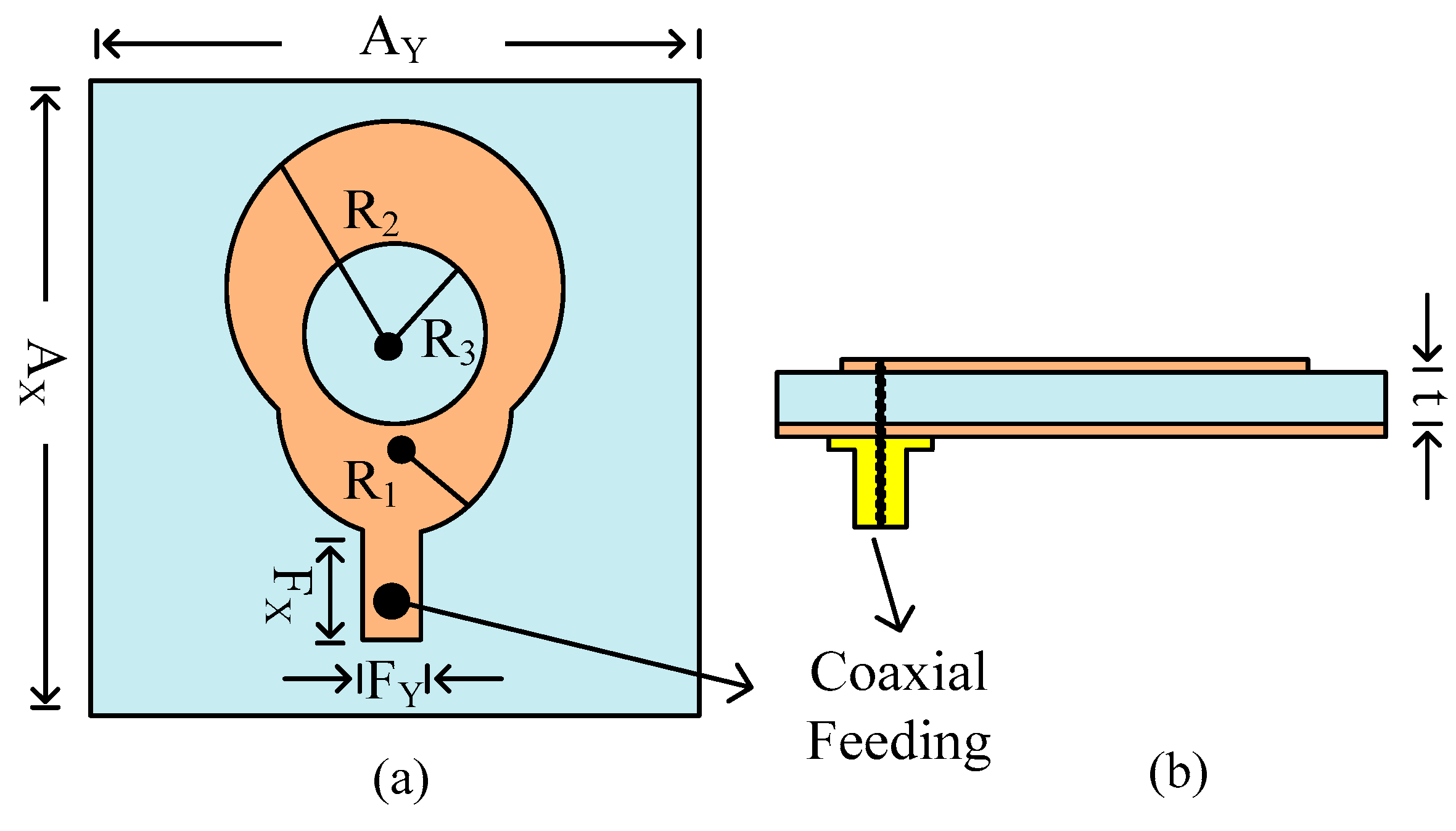


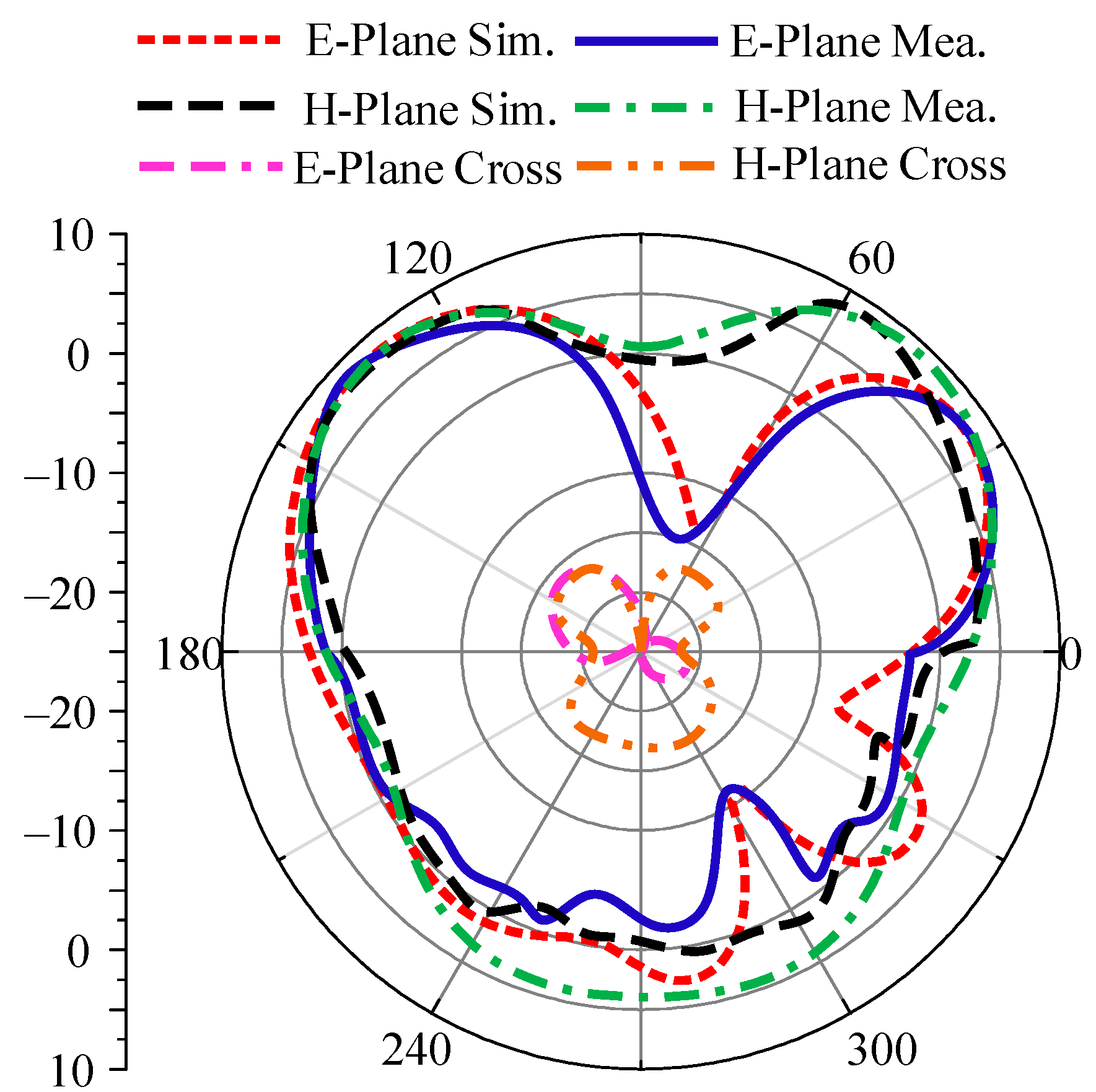
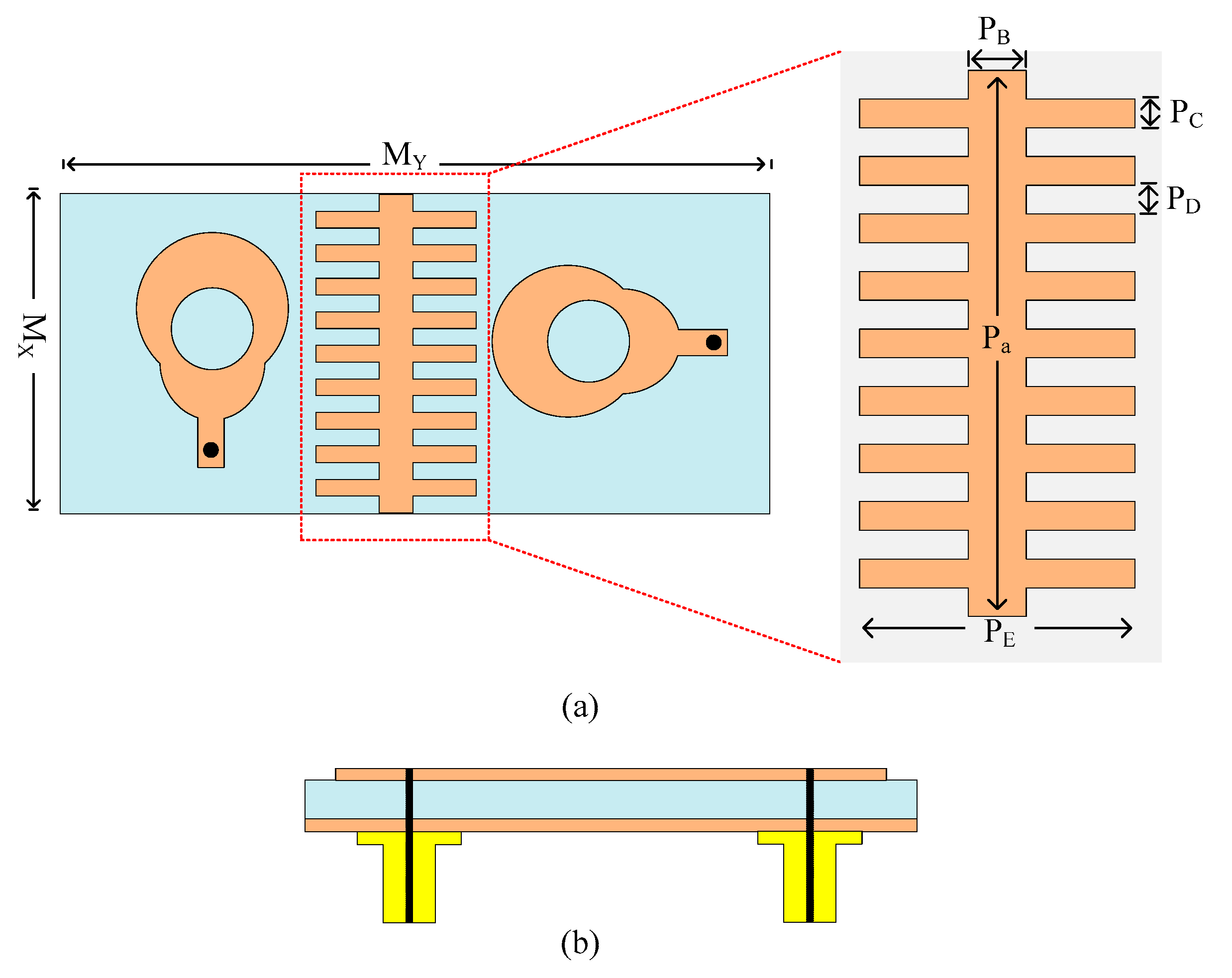

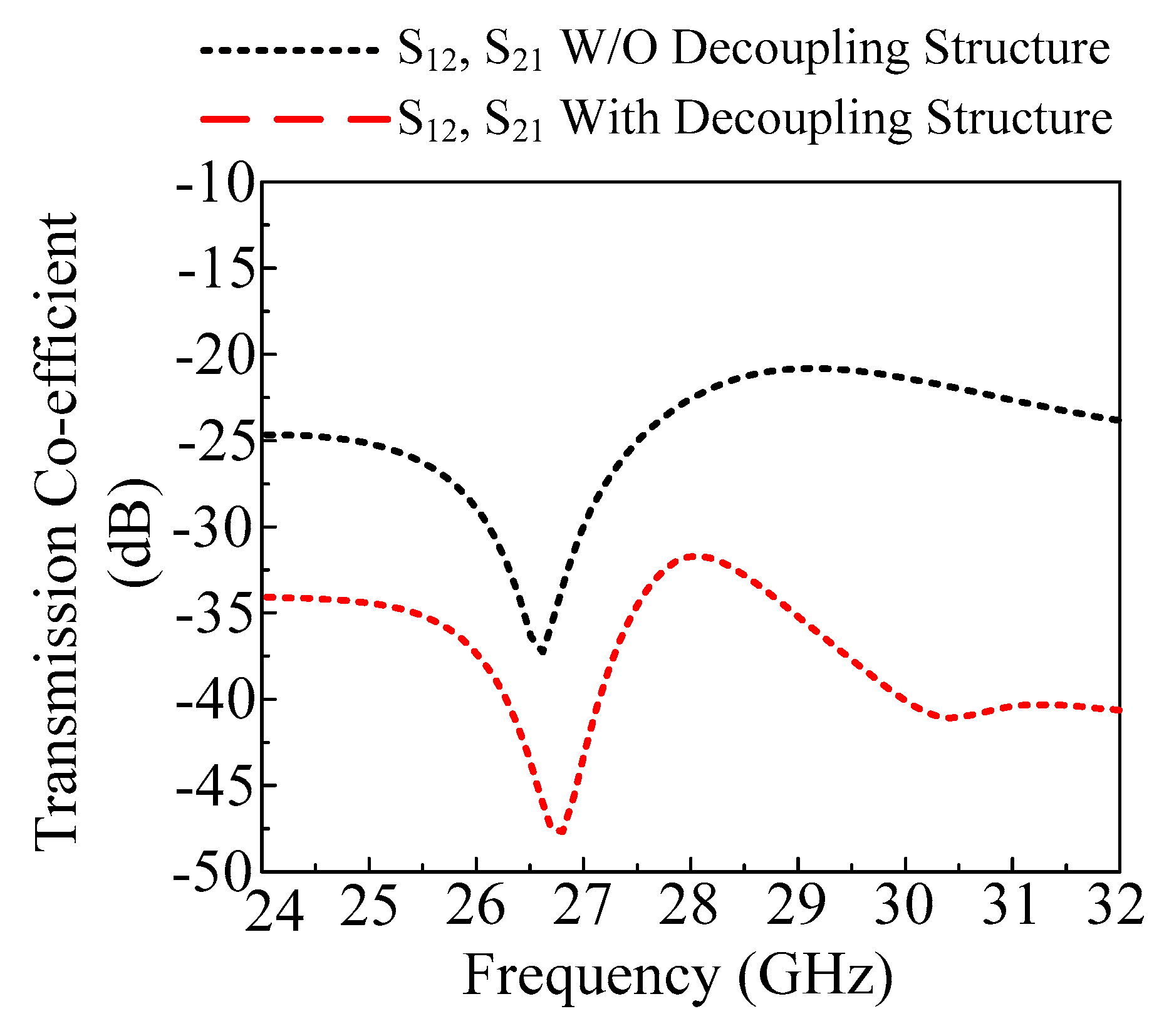
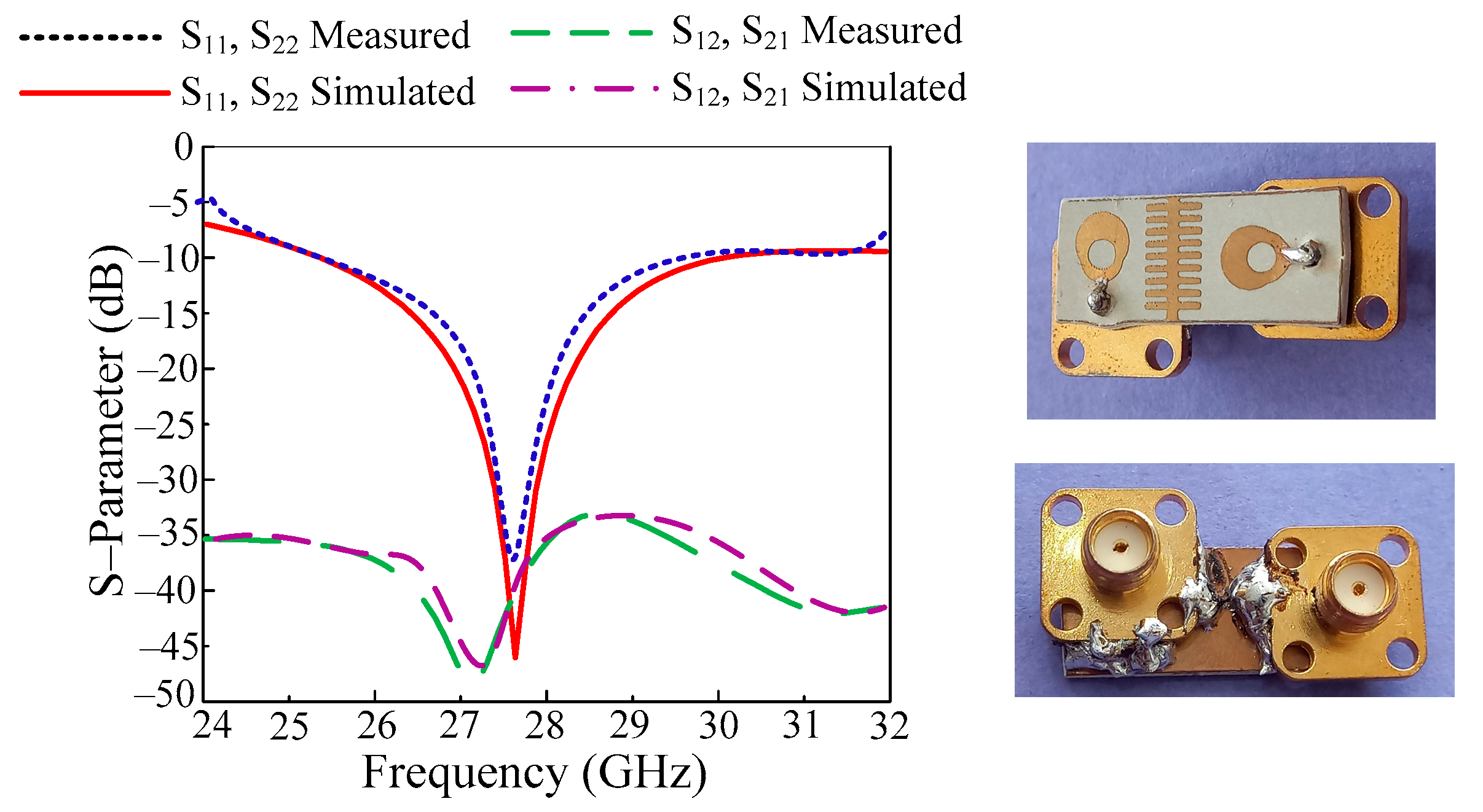
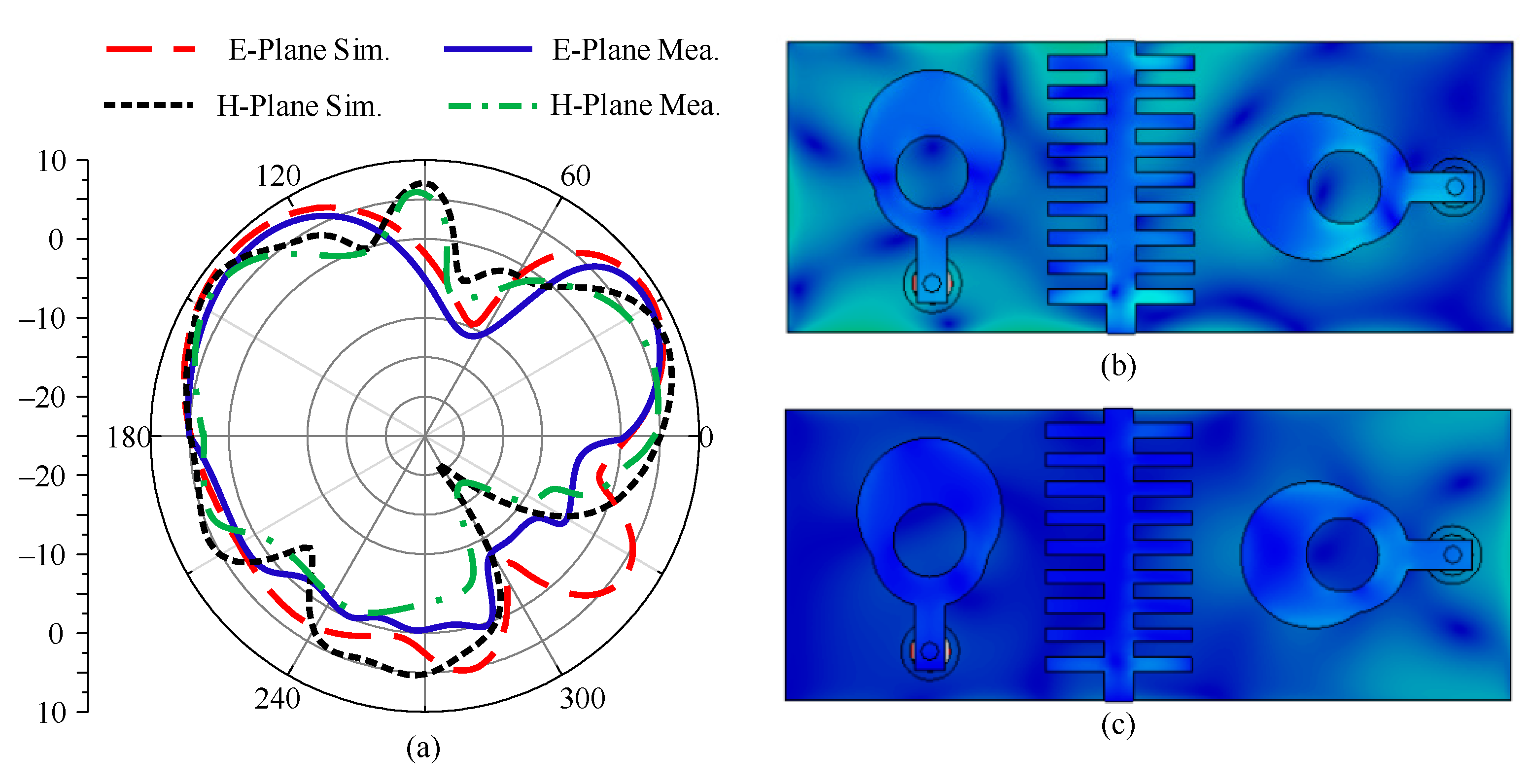
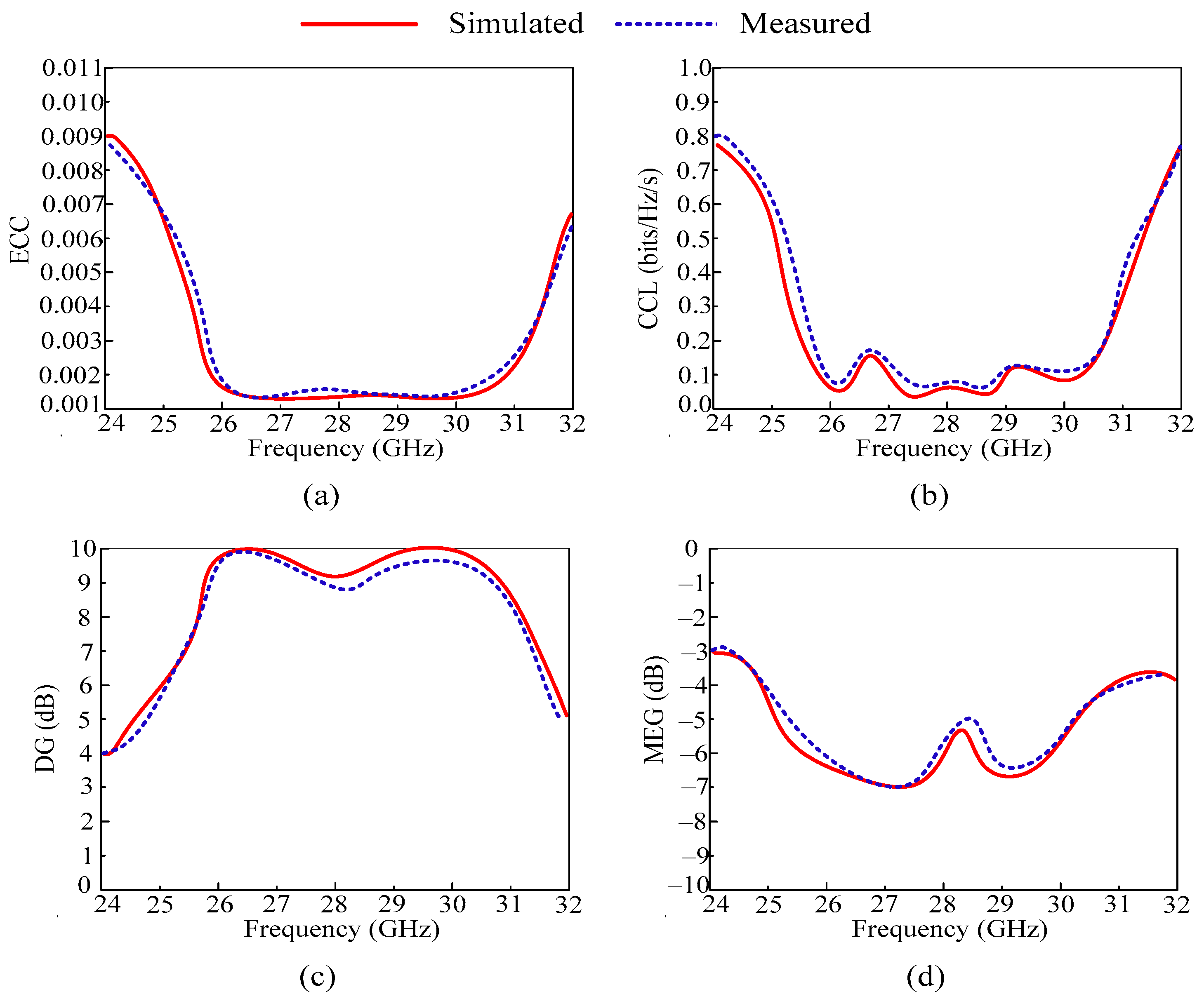
| Ref | Antenna Size (mm × mm × mm) | Bandwidth (GHz) | Isolation (dB) | Gain (dBi) | ECC | No. of Ports | Antenna Type | Substrate Material | Technique Used |
|---|---|---|---|---|---|---|---|---|---|
| [19] | 85 × 21 × 0.508 | 27–32 | 38 | 10.5 | – | 2 | Antipodal Fermi Tapered slot | RO4003 | Metamaterial |
| [20] | 26 × 14.5 × 0.508 | 26.5–29.5 | 38 | 4.5 | 0.0001 | 2 | Monopole Antenna | RT5880 | Metamaterial |
| [28] | 20 × 20 × 0.254 | 27.2–28.5 | 24 | – | 0.013 | 2 | DRA | RT5880 | Parasitic Patch |
| [30] | 25 × 15 × 0.25 | 26–29 | 25 | – | 0.007 | 2 | DRA | RT5881 | Parasitic Patch |
| [31] | 12 × 24 × 1.51 | 20–28 | 15 | – | – | 2 | Monopole Antenna | RT5880 | Parasitic Patch |
| This work | 25 × 10 × 1.52 | 25.25–29.85 | 47 | 10.8 | 0.001 | 2 | Monopole Antenna | RT6002 | Parasitic Patch |
Disclaimer/Publisher’s Note: The statements, opinions and data contained in all publications are solely those of the individual author(s) and contributor(s) and not of MDPI and/or the editor(s). MDPI and/or the editor(s) disclaim responsibility for any injury to people or property resulting from any ideas, methods, instructions or products referred to in the content. |
© 2023 by the authors. Licensee MDPI, Basel, Switzerland. This article is an open access article distributed under the terms and conditions of the Creative Commons Attribution (CC BY) license (https://creativecommons.org/licenses/by/4.0/).
Share and Cite
Islam, T.; Alsaleem, F.; Alsunaydih, F.N.; Alhassoon, K. Mutual Coupling Reduction in Compact MIMO Antenna Operating on 28 GHz by Using Novel Decoupling Structure. Micromachines 2023, 14, 2065. https://doi.org/10.3390/mi14112065
Islam T, Alsaleem F, Alsunaydih FN, Alhassoon K. Mutual Coupling Reduction in Compact MIMO Antenna Operating on 28 GHz by Using Novel Decoupling Structure. Micromachines. 2023; 14(11):2065. https://doi.org/10.3390/mi14112065
Chicago/Turabian StyleIslam, Tanvir, Fahd Alsaleem, Fahad N. Alsunaydih, and Khaled Alhassoon. 2023. "Mutual Coupling Reduction in Compact MIMO Antenna Operating on 28 GHz by Using Novel Decoupling Structure" Micromachines 14, no. 11: 2065. https://doi.org/10.3390/mi14112065
APA StyleIslam, T., Alsaleem, F., Alsunaydih, F. N., & Alhassoon, K. (2023). Mutual Coupling Reduction in Compact MIMO Antenna Operating on 28 GHz by Using Novel Decoupling Structure. Micromachines, 14(11), 2065. https://doi.org/10.3390/mi14112065






